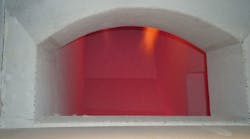Manufacturers have seen a progression of priorities over the past several decades — from product quality, to productivity, to the latest trend, process quality. Note, product quality and productivity have never diminished in importance, but process quality aims to identify and categorize the efficiency, cost effectiveness, and even the sustainability of a production process. In this light, designers of furnaces, ladles, and crucibles are devoting more attention to the performance of lining materials and systems. The heat-resistant furnace linings of melting and pouring furnaces contribute significantly to the overall efficiency of such systems, and also help to extend the service life of a furnace.
StrikoWestofen credits a new-concept approach to furnace relining that it claims matches the quality of original designs for the fact that its projects frequently achieve performance standards comparable with newly introduced furnace designs. “Work done incorrectly shortens the service life of the equipment, reduces the melting capacity, and increases the energy consumption by up to 30%,” explained Holger Stephan, manager of Service and Spare Parts at StrikoWestofen. “Furthermore, additional cost-intensive and time-consuming work is often necessary – like operating pouring furnaces with porous plugs.”
Refractory linings for melting and pouring furnaces are high-tech concepts. The materials — StrikoWestofen uses up to six different types of refractory and insulating materials — as well as the entire interior furnace geometry, are precisely engineered and constantly optimized.
To reline a melting system, it offers a complete engineering service that it stated would achieve optimal results. In a first step, service technicians record the current performance and energy consumption of the furnace under real foundry conditions. Based on this assessment, StrikoWestofen compiles a forecast of the values to be expected after a complete lining renewal.
“The use of state-of-the-art materials and the latest engineering results often allow us to achieve values comparable with those of up-to-date models – at only 20% of the purchase price,” Stephan Holger explained.
Reducing gas consumption
“At Skoda Auto a. s., in the Czech Republic, we were able to reduce the gas consumption per metric ton of molten material by 40%, from 102 to 61.2 cubic meters, by relining the furnace and training employees in a targeted way.
“In terms of the annual melting performance at Skoda Auto’s Mladá Boleslav foundry, the costs for lining a total of four melting furnaces were rapidly recovered after only 10 months,” Stephan detailed. Relining is more than maintenance: it is a permanent improvement of the original system. Once a furnace has been relined, StrikoWestofen validates the forecast values via field testing, to guarantee optimal process quality.
Service life of 10 years or more is not unusual for its furnace linings, according to StrikoWestofen. This durability results from the exacting process for selecting materials, as well as the consideration of all angles and gradients inside the furnace. As such, areas that endure particular stress are lined with especially resistant refractories, and the angle of flow is optimized in order to minimize the load on the materials. Trained service personnel may make small repairs on site, but even the most well planned lining must be replaced at some time.
If it is necessary to reline a pouring furnace, StrikoWestofen does not recommend the most common approach, relining at the plant site. The problem with this is that all subsequent steps have to be done on-site, too, in particular the drying of the fireproof lining. If drying takes place at the foundry, it can only be done via the heating elements built into the furnace. This strains the elements, disrupts plant production process for several days at time, and requires the foundry to cover the electrical power costs.
Instead, StrikoWestofen dissassembles and relocates the furnace to its own factory, where the redesign takes place. There, the body of a furnace is tested for pressure tightness and the lining is replaced. New refractory material is dried in a purpose-built drying chamber.
The advantage of this is that there is no strain on the heating elements, and the drying chamber guarantees that the refractory contains no residual humidity. (Humidity could precipitate as hydrogen in the melt, contaminate it, or worse, cause a hydrogen explosion.) Thus, expensive and time-consuming initial operations with porous plugs can be avoided. And, the drying process takes only one-third as long as drying in situ. In this way, the furnace can restored to operation at the foundry more quickly.
To compensate for the disruption in foundry operations, StrikoWestofen has a series of pouring furnaces available for the duration of the relining process.









